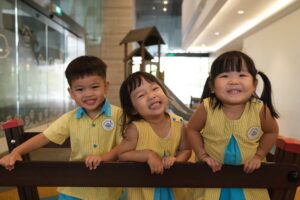BACK
Performing arts is an excellent medium to enhance learning in young children. Performing arts genre may include dance, music, opera, theatre and musical theatre, magic, illusion, mime, spoken word, puppetry, circus arts, performance art, recitation and public speaking. There is also a specialized form of fine art, in which the artists perform their work live to an audience. dance, music, opera, theatre and musical theatre, magic, illusion, mime, spoken word, puppetry, circus arts, performance art, recitation and public speaking. There is also a specialized form of fine art, in which the artists perform their work live to an audience.
At The Little Skool-House, in-line with one of our principles of learning, “Creative Expressions Broadens Children Development”, rich learning areas are set up with elements in creative expressions which enhances the children’s learning process.
Performing comes naturally for very young children and the level of self-consciousness increases as they approach pre-school years. The key to instilling their love is to start encouraging and positively reinforce any performing efforts from young. While skills can be honed progressively, confidence and motivation are cultivated right from the minute they can utter a word. Puppets are a great way to start with as the use of the puppet provides a safe proxy for the child to experiment with performing. The risk is greatly reduced as the attention is on the puppet, and not the child. This works for children who are naturally shy or not as confident.
We see children’s abilities and learning styles develop and unfold while they are engaged in performing arts. Children’s imagination is ignited through active exploration and play. Below are some strategies which you can work with your child to form the best building blocks for their development.
Adaptation can be embraced to make performing arts relevant for young children in the home environment. Exposing children to simple story narration and role playing will allow them to gain a better understanding of the text. As a family, incorporating Reader’s Theatre, where children read simple scripts aloud from a story, is one way to allow your child to portray his/her favorite story, confidently with familiar adults. Through the use of movement and voice, your child is given the opportunity to enhance communication and expression without the emphasis for memorizing words. Being a home-based activity, with the familiarity of the environment, also makes it more conducive for little performances to happen.
How about reading a story aloud together? A form of choral reading, this way of expression is a great approach to playing around with the spoken language. Planning short snippets of time at home where you can start with short passages from your child’s favorite story and reading aloud for him/her to model. Besides enjoying the story, this activity develops the use of voice, intonation, speed, and pitch to demonstrate emotions through reading. At the same time, this makes reading a fun process, and children will eventually develop strategies to read independently in the long run. Reading need not be limited to take place indoors. It can also be in the outdoors where the immediate interaction with the nature around them can be incorporated. This helps to bring a sense of liveliness and vitality in their existing common environment.
Why stop at reading a story where you can live in it? With simple props and costumes that you can provide for your child, he/she can be exposed to different perspectives of the story and effectively portray the characters, emotions and plot of the story. Be creative in this, allow your child to use household items to create a costume and have silly fun together. This hones the level of expression and creative thinking in the process. Your child is also given the autonomy to make sense of the story in their own understanding and develop new ideas to express his/her emotions and ideas.
In order to develop children in their competencies and dispositions necessary for performance, ample opportunities can be given to the children to consistently use musical instruments and songs during activities. Music is an important accompaniment to puppetry; a simple box, a metal plate and stick or even your voice can do wonders in supporting and facilitating children in exploring the performing arts a lot more. Introduction of musical instruments also allows children to appreciate music which increases the children’s awareness of stage presence and engagement level. Both you and your child’s experiences could be enriched through these pathways.
The role of a parent is crucial, as you will be supporting, participating and engaging your child in his/her daily interaction. Instilling love for performing arts in young children will take time and they should be given the freedom and space to explore any dialogue and interaction. Children’s level of confidence also plays a huge part in building their own development, mastery and application of skills. There should be moments where your child can re-visit and return to his/her experiences without being largely influenced by the adults’ preconceptions. Start your day with some elements of performing arts!



